Inpex Bundle
Can INPEX Navigate the Energy Transition Successfully?
INPEX Corporation, a key player in the global oil and gas industry, is charting a course through the evolving energy landscape. Established in 1966, this Japanese energy giant has evolved from its early days to become a significant force, particularly with its massive Ichthys LNG Project in Australia. With a focus on strategic expansion and technological innovation, INPEX is aiming for net-zero emissions by 2050.
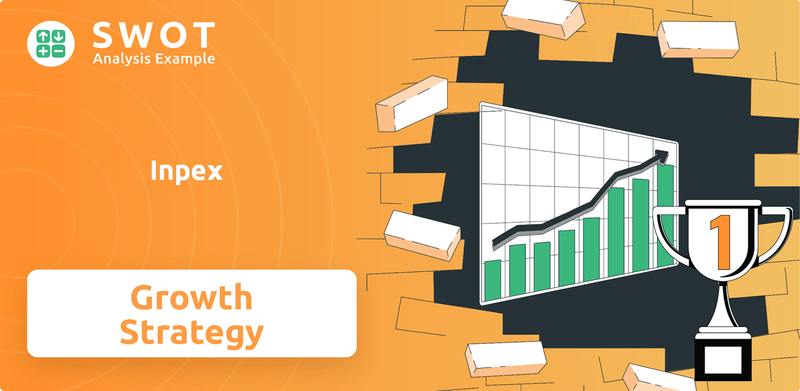
This Inpex SWOT Analysis provides a comprehensive overview of the company's current position and future potential. Understanding the Inpex growth strategy is crucial for investors and analysts alike, especially considering the dynamic energy sector outlook and the company's ambitious goals. Examining Inpex's future prospects requires a deep dive into its exploration and production projects, renewable energy initiatives, and its impact on the global energy market, offering valuable insights into this Japanese energy company's trajectory.
How Is Inpex Expanding Its Reach?
The Inpex growth strategy is multifaceted, focusing on both expanding its traditional oil and gas business and investing in lower-carbon energy solutions. This approach is designed to ensure long-term growth and sustainability in a changing global energy landscape. The company's strategic goals for 2024 and beyond include significant investments in both existing and new energy sectors, aiming to capitalize on emerging opportunities while mitigating risks.
A key element of Inpex's expansion involves increasing its natural gas and LNG production capacity. This includes enhancing the liquefaction capabilities of existing projects and developing new ones. Furthermore, Inpex is actively working to strengthen its LNG trading capabilities, which will provide greater flexibility in its supply chain and allow it to respond more effectively to market demands. The company's strategic initiatives are also geared towards achieving its net-zero carbon emissions target by 2050.
Inpex's commitment to lower-carbon solutions is evident through its investments in carbon capture and storage (CCS), hydrogen production, and renewable energy projects. These initiatives are crucial for diversifying its energy portfolio and aligning with global efforts to reduce carbon emissions. The company's approach reflects a comprehensive strategy to navigate the evolving energy sector and maintain a competitive edge.
Inpex is expanding its LNG business, including increasing liquefaction capacity at the Ichthys LNG Project. The company is targeting a final investment decision (FID) for the Abadi LNG project in Indonesia by 2027. This project is expected to contribute approximately 9.5 million metric tons per year (mmt/y) of LNG, starting production in the early 2030s.
Inpex is investing in lower-carbon solutions, including carbon capture and storage (CCS) and hydrogen production. The company is exploring green hydrogen production using renewable energy and is also involved in e-methane creation. In November 2024, Inpex launched commercial production and supply of RD40, a renewable diesel blend, with plans to expand its use in various industries.
Inpex is pursuing geothermal power generation projects, leveraging its expertise from oil and natural gas development. The company is conducting joint geothermal studies in Indonesia and exploring offshore wind and geothermal projects in Japan. These initiatives aim to leverage know-how from Australian projects.
Inpex aims to achieve net-zero carbon emissions by 2050. The company's strategic goals include expanding LNG production, investing in lower-carbon solutions, and diversifying its energy portfolio. These efforts are part of a broader strategy to ensure long-term growth and sustainability in the energy sector.
Inpex's expansion strategy focuses on LNG, CCS, hydrogen, and renewable energy. The company is enhancing its LNG trading capabilities to enable flexible supply. These initiatives are supported by strategic partnerships and investments to drive growth.
- Expansion of LNG capacity at existing projects.
- Final investment decision (FID) for the Abadi LNG project by 2027.
- Development of lower-carbon solutions, including CCS and hydrogen.
- Commercial production and supply of renewable diesel blends.
- Exploration of geothermal and offshore wind projects.
Inpex SWOT Analysis
- Complete SWOT Breakdown
- Fully Customizable
- Editable in Excel & Word
- Professional Formatting
- Investor-Ready Format
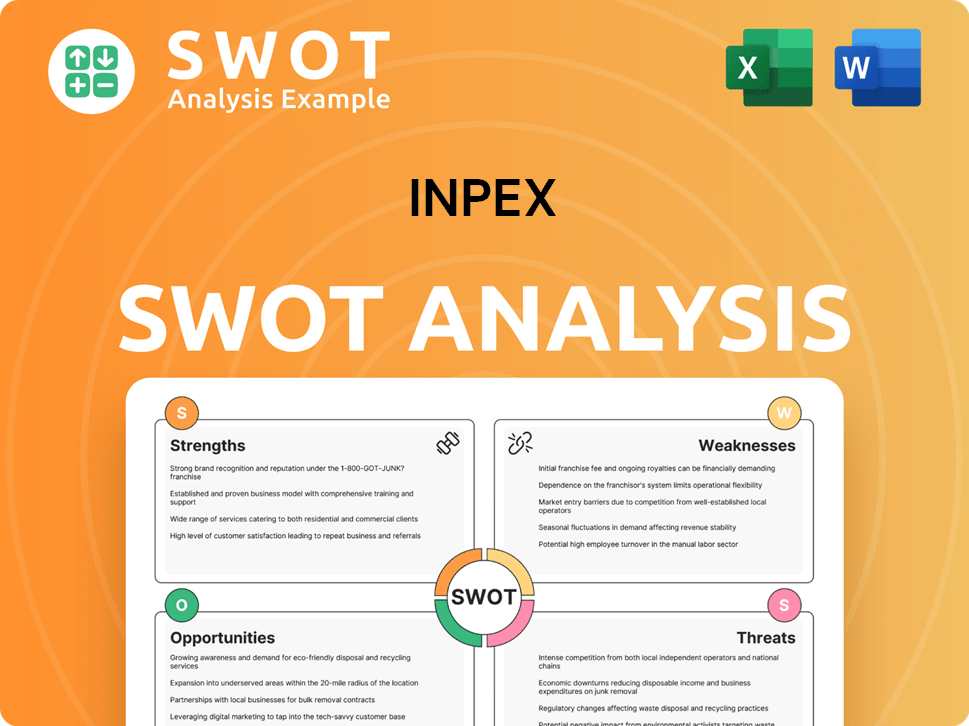
How Does Inpex Invest in Innovation?
The Revenue Streams & Business Model of Inpex highlights how the company leverages technology and innovation as key drivers for its sustained growth. This is especially crucial as it transitions towards a net-zero carbon society by 2050. The firm's strategic focus is on achieving cost-competitive results with cleaner outputs, primarily shifting towards gas as its main energy source.
A significant portion of the company's strategy involves cutting-edge technology acquired through its oil and gas development business. This technology is then applied to environmentally friendly projects, demonstrating a commitment to sustainability. This approach is central to understanding the Inpex growth strategy and its future prospects within the energy sector outlook.
The company's technological advancements are primarily concentrated in areas like carbon capture, utilization, and storage (CCUS), hydrogen, renewables, and carbon recycling. These initiatives support the company's strategic goals for 2024 and beyond, positioning it as a key player in the Japanese energy company landscape.
INPEX has a long history with CCUS, having established Japan's first CCUS project in 1988. The company aims to reduce CO2 emissions from its upstream operations through CCUS and natural gas, aligning with its sustainability report goals. In May 2025, INPEX, Nippon Steel, and Kanto Natural Gas Development entered a consignment contract for engineering and design work on the Metropolitan Area Advanced CCS Project.
INPEX is investing in research and development to establish a hydrogen value chain. This includes the production and supply of hydrogen, potentially using natural gas from its operations to produce carbon-free hydrogen through gas reforming combined with CCUS. This initiative is a key component of Inpex's renewable energy initiatives.
The company is actively involved in developing and commercializing innovative technologies, such as methanation and sustainable aviation fuel (SAF) production. These advancements are critical to the Inpex technological advancements and its impact on the global energy market.
I-RHEX serves as a central point for industry-government-academia networks, fostering the development and advancement of clean energy technologies. This hub is crucial for supporting Inpex's exploration and production projects and its overall corporate social responsibility efforts.
Digital transformation (DX) activities are being strengthened to enhance efficiency and create new value. This focus on DX supports Inpex's financial performance review and its ability to navigate the Inpex competitive landscape.
In February 2025, INPEX formalized its 'INPEX Vision 2035,' which designates lower-carbon solutions leveraging CCS and hydrogen as one of its growth pillars. The goal is to promote greenhouse gas (GHG) reduction solutions for third parties. This vision is a key element of Inpex's overseas expansion plans and its overall Inpex future prospects.
INPEX's commitment to innovation and technology is central to its strategy. The company is actively involved in various projects, including CCUS, hydrogen production, and renewable energy initiatives. These advancements are crucial for the company's long-term sustainability and its ability to capitalize on investment opportunities in the evolving oil and gas industry.
- CCUS Projects: Significant investment in projects to capture and store carbon emissions.
- Hydrogen Initiatives: Development of a hydrogen value chain, including production and supply.
- Renewable Energy: Exploration of new technologies like methanation and SAF production.
- Digital Transformation: Strengthening DX activities to improve efficiency and create new value.
Inpex PESTLE Analysis
- Covers All 6 PESTLE Categories
- No Research Needed – Save Hours of Work
- Built by Experts, Trusted by Consultants
- Instant Download, Ready to Use
- 100% Editable, Fully Customizable
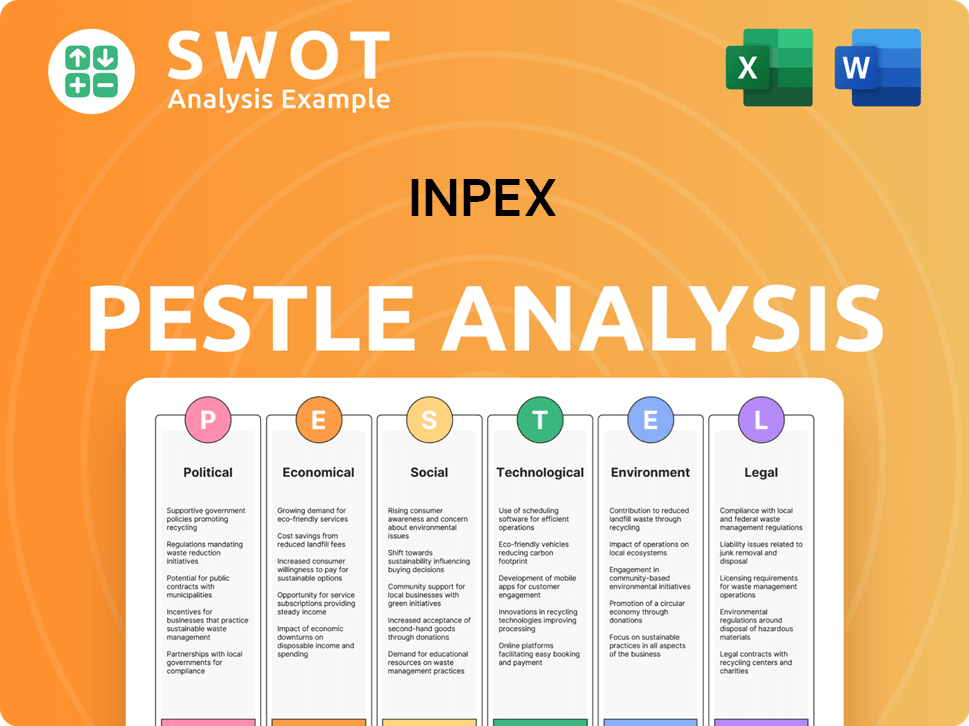
What Is Inpex’s Growth Forecast?
In 2024, INPEX Corporation demonstrated robust financial health. The company's revenue reached ¥2,265.8 billion, marking a 4.7% increase. Operating profit saw a significant rise of 14.1%, totaling ¥1,271.7 billion. Furthermore, profit attributable to owners of the parent increased by 32.8% to ¥427.3 billion, reflecting strong operational efficiency and market performance. This positive trend is a key indicator of INPEX's successful Mission, Vision & Core Values of Inpex.
The company's total assets grew to ¥7,380.8 billion, and equity attributable to owners reached ¥4,821.8 billion by the end of December 31, 2024. These figures highlight the company's solid financial foundation and its ability to generate value. The impressive financial results underscore the effectiveness of INPEX's strategies within the dynamic oil and gas industry.
Looking ahead to 2025, INPEX anticipates a more challenging environment. Projected decreases in both revenue and profits are expected due to the anticipated decline in crude oil prices and planned maintenance activities. Despite these challenges, INPEX is focused on maintaining production levels and enhancing shareholder returns.
INPEX's long-term strategy, as outlined in Vision 2035, aims for substantial growth. The company is targeting a 60% increase in cash flow from operating activities (CFFO) compared to 2024 levels. This strategic focus is crucial for navigating the complexities of the energy sector outlook.
INPEX has set ambitious financial targets to drive future success. The company aims for a Return on Equity (ROE) and Return on Invested Capital (ROIC) of 10% or more. These targets are designed to ensure sustained profitability and enhance shareholder value.
A key element of INPEX's growth strategy is increasing production capacity. The company is aiming for a production of 1 million barrels of oil equivalent per day (mmboe/d) in the long term. This represents a significant increase from current levels, which are approximately 640,000 boe/d.
For the three months ended March 31, 2025, revenue decreased by 10.0% to ¥536.8 billion. However, profit attributable to owners of the parent increased by 3.7% to ¥126.2 billion. These figures reflect the company's resilience and ability to adapt to changing market conditions.
INPEX is committed to enhancing shareholder returns despite the anticipated challenges. The company plans to achieve this through strategic dividends and share buybacks. This commitment underscores INPEX's focus on creating long-term value for its investors.
The company's performance is significantly influenced by global market conditions. The recent revision of financial forecasts for 2025 reflects the impact of lower crude oil prices and the appreciation of the Japanese yen. These factors highlight the importance of strategic flexibility.
Inpex Business Model Canvas
- Complete 9-Block Business Model Canvas
- Effortlessly Communicate Your Business Strategy
- Investor-Ready BMC Format
- 100% Editable and Customizable
- Clear and Structured Layout
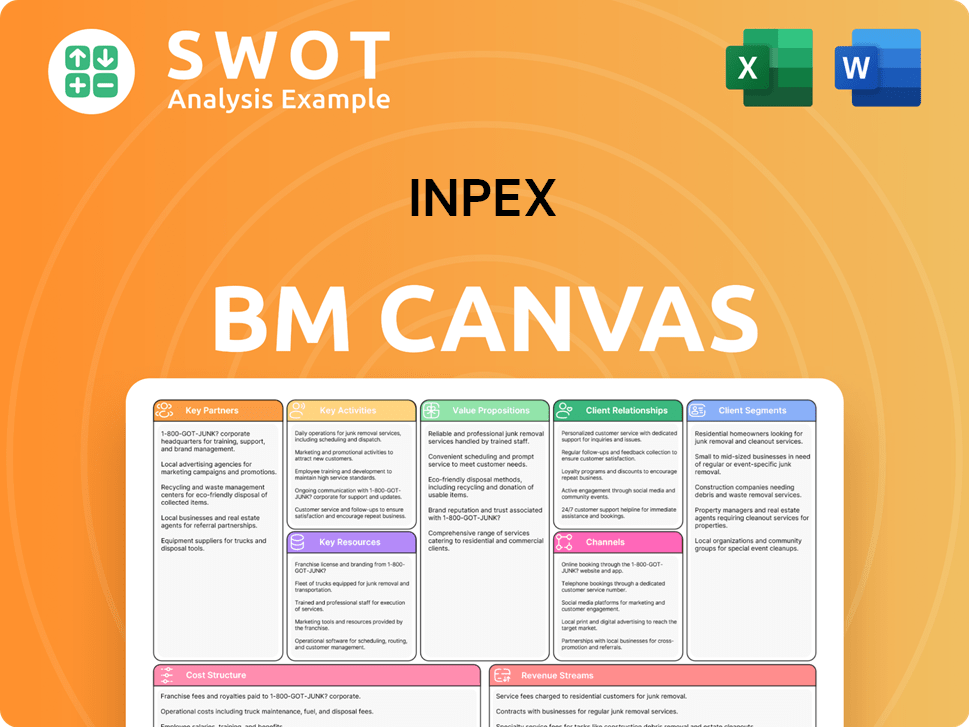
What Risks Could Slow Inpex’s Growth?
The Inpex company analysis reveals a complex landscape of potential risks and obstacles that could influence its future growth. These challenges span from volatile market conditions to operational disruptions and evolving regulatory environments. Understanding these risks is crucial for assessing Inpex's strategic resilience and long-term viability within the dynamic energy sector.
Inherent in the oil and gas industry are price fluctuations and shifts in demand, which directly impact Inpex's financial performance. Furthermore, the company faces operational risks related to exploration, development, and transportation, including potential accidents and system failures. These factors, alongside increasing competition and the energy transition, present significant hurdles for Inpex's growth strategy.
Moreover, regulatory changes, particularly those concerning climate policy and carbon emissions, pose ongoing challenges. Supply chain vulnerabilities, technological disruptions, and internal resource constraints add to the complexity. Addressing these multifaceted risks requires a proactive and adaptable approach to ensure sustainable growth and operational success.
Inpex's financial performance is significantly affected by the fluctuating prices of crude oil and natural gas. The demand for these resources is also subject to market dynamics, which further complicates financial forecasting. These uncertainties necessitate robust hedging strategies and flexible operational plans.
Operational accidents and disasters during exploration, development, production, and transportation pose significant risks. These events can lead to substantial costs, infrastructural damage, and potential loss of life. Comprehensive safety protocols and emergency response plans are essential for mitigating these risks.
Fluctuations in foreign exchange rates can significantly impact Inpex's financial results. As a global company, Inpex's revenue and costs are denominated in various currencies. Effective currency risk management is crucial to protect profitability.
System failures, including those caused by natural disasters and cyberattacks, can disrupt operations, potentially leading to significant financial losses and reputational damage. Cybersecurity measures and robust disaster recovery plans are vital for business continuity. In 2024, the energy sector experienced a 20% increase in cyberattacks.
The accelerating energy transition and the emergence of new players in the renewable energy sector intensify competition. This requires Inpex to adapt its business model and invest in sustainable energy solutions. The global renewable energy market is projected to grow by 15% annually through 2030.
Changes in regulations, particularly those related to climate policy and carbon emissions, can impact Inpex's operations and investment strategies. Compliance with environmental standards and the adoption of low-carbon technologies are becoming increasingly important. The EU's carbon pricing mechanism has increased the cost of emissions by 30% in the last year.
Supply chain disruptions, whether due to geopolitical events or economic factors, can affect Inpex's ability to procure necessary materials and services, thereby impacting project timelines and costs. Diversification of suppliers and robust supply chain management practices are essential. Recent events have shown that companies with diversified supply chains experienced 10% fewer disruptions.
Technological advancements in emerging energy sources pose a risk to the company's existing assets and market position. Investing in research and development and adopting new technologies are crucial for maintaining a competitive edge. The investment in green hydrogen technology has increased by 25% in the last year.
Internal resource constraints, such as labor disputes or shortages due to infectious diseases, can disrupt operations and hinder project progress. Effective human resource management and contingency planning are necessary. The labor market for skilled energy professionals is experiencing a 5% shortage.
Inpex addresses these risks through diversification into renewable energy projects. Risk management frameworks are in place to identify and respond to operational disruptions. Strengthening and expanding the natural gas pipeline network enhances energy supply infrastructure resilience. Inpex aims to reduce its carbon intensity by 30% by 2030 through strategic investments.
Inpex Porter's Five Forces Analysis
- Covers All 5 Competitive Forces in Detail
- Structured for Consultants, Students, and Founders
- 100% Editable in Microsoft Word & Excel
- Instant Digital Download – Use Immediately
- Compatible with Mac & PC – Fully Unlocked
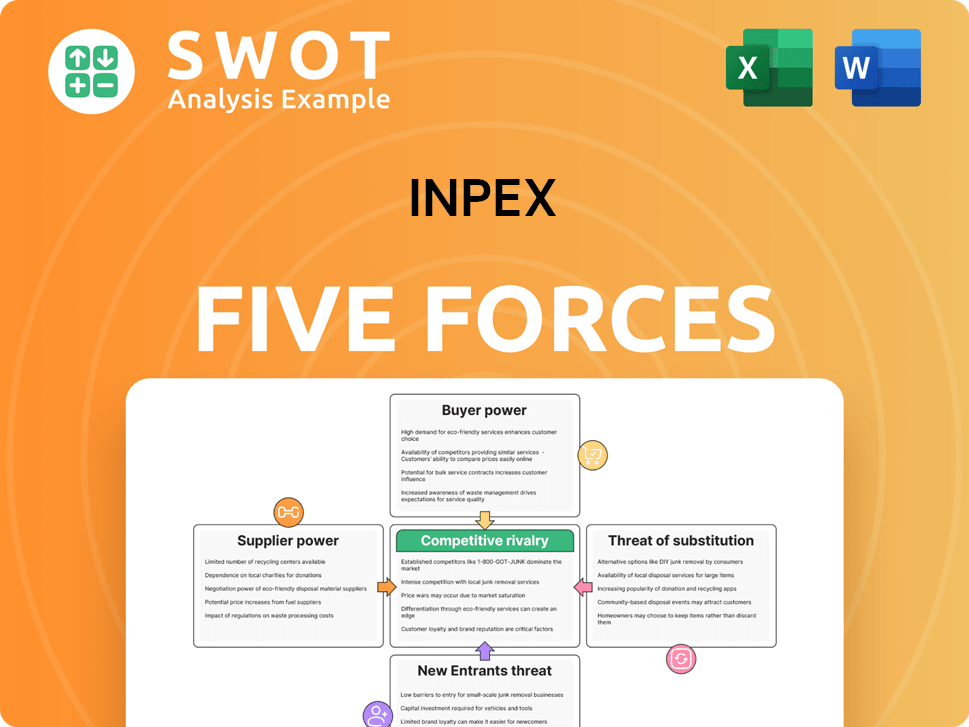
Related Blogs
- What are Mission Vision & Core Values of Inpex Company?
- What is Competitive Landscape of Inpex Company?
- How Does Inpex Company Work?
- What is Sales and Marketing Strategy of Inpex Company?
- What is Brief History of Inpex Company?
- Who Owns Inpex Company?
- What is Customer Demographics and Target Market of Inpex Company?
Disclaimer
All information, articles, and product details provided on this website are for general informational and educational purposes only. We do not claim any ownership over, nor do we intend to infringe upon, any trademarks, copyrights, logos, brand names, or other intellectual property mentioned or depicted on this site. Such intellectual property remains the property of its respective owners, and any references here are made solely for identification or informational purposes, without implying any affiliation, endorsement, or partnership.
We make no representations or warranties, express or implied, regarding the accuracy, completeness, or suitability of any content or products presented. Nothing on this website should be construed as legal, tax, investment, financial, medical, or other professional advice. In addition, no part of this site—including articles or product references—constitutes a solicitation, recommendation, endorsement, advertisement, or offer to buy or sell any securities, franchises, or other financial instruments, particularly in jurisdictions where such activity would be unlawful.
All content is of a general nature and may not address the specific circumstances of any individual or entity. It is not a substitute for professional advice or services. Any actions you take based on the information provided here are strictly at your own risk. You accept full responsibility for any decisions or outcomes arising from your use of this website and agree to release us from any liability in connection with your use of, or reliance upon, the content or products found herein.